

Biomass Energy Pros and Cons - Energy Informative. Biomass is organic matter from plants and animals (microorganisms).

Photosynthesis is the name process that stores the energy from sunlight in plants. Animals get this energy through eating the plants. The Energy Story - Chapter 10: Biomass Energy. Biomass is matter usually thought of as garbage.
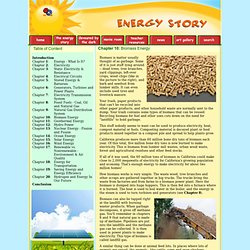
Some of it is just stuff lying around -- dead trees, tree branches, yard clippings, left-over crops, wood chips (like in the picture to the right), and bark and sawdust from lumber mills. It can even include used tires and livestock manure. Your trash, paper products that can't be recycled into other paper products, and other household waste are normally sent to the dump. Your trash contains some types of biomass that can be reused. Recycling biomass for fuel and other uses cuts down on the need for "landfills" to hold garbage. This stuff nobody seems to want can be used to produce electricity, heat, compost material or fuels. California produces more than 60 million bone dry tons of biomass each year.
If all of it was used, the 60 million tons of biomass in California could make close to 2,000 megawatts of electricity for California's growing population and economy. How Biomass Energy Works. Advantages and Disadvantages of Biomass. Speaking of resources, the world changes pace everyday.

First there was evolution which took us from wood to steel to iron (and more), then development happened and took us to the stage that we are in now. Now we see that there are distinct shifts in policies which have taken us back to our roots and have been able to reacquaint us with the natural resources that we once used. One of those resources was biomass. This article will try to give you an in-depth review on the advantages and disadvantages of biomass energy.
Drax power station. Drax is a large coal-fired power station in North Yorkshire, England, capable of co-firing biomass and petcoke, and its name comes from the nearby village of Drax.
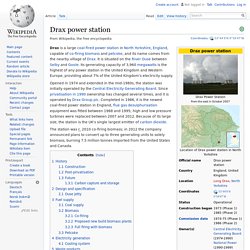
It is situated on the River Ouse between Selby and Goole. Its generating capacity of 3,960 megawatts is the highest of any power station in the United Kingdom and Western Europe, providing about 7% of the United Kingdom's electricity supply. Opened in 1974 and extended in the mid-1980s, the station was initially operated by the Central Electricity Generating Board. Since privatisation in 1990 ownership has changed several times, and it is operated by Drax Group plc. Completed in 1986, it is the newest coal-fired power station in England, flue gas desulphurisation equipment was fitted between 1988 and 1995; high and low pressure turbines were replaced between 2007 and 2012. History[edit] Bioenergy News, Bioenergy Articles, Bioenergy Photos. Gasification. Gasification is a process that converts organic or fossil based carbonaceous materials into carbon monoxide, hydrogen and carbon dioxide.
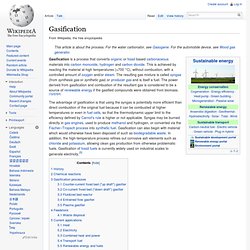
This is achieved by reacting the material at high temperatures (>700 °C), without combustion, with a controlled amount of oxygen and/or steam. The resulting gas mixture is called syngas (from synthesis gas or synthetic gas) or producer gas and is itself a fuel. The power derived from gasification and combustion of the resultant gas is considered to be a source of renewable energy if the gasified compounds were obtained from biomass.[1][2][3][4] The advantage of gasification is that using the syngas is potentially more efficient than direct combustion of the original fuel because it can be combusted at higher temperatures or even in fuel cells, so that the thermodynamic upper limit to the efficiency defined by Carnot's rule is higher or not applicable.
History[edit] [edit] In a gasifier, the carbonaceous material undergoes several different processes: Biomass Power and Thermal. Biomass Rules, LLC. Biomass. Sugarcane plantation in Brazil (State of São Paulo).
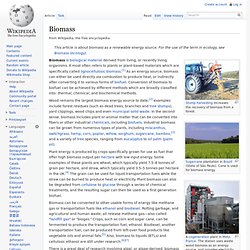
Cane is used for biomass energy. A cogeneration plant in Metz, France. The station uses waste wood biomass as an energy source, and provides electricity and heat for 30,000 dwellings. Biomass is biological material derived from living, or recently living organisms. It most often refers to plants or plant-based materials which are specifically called lignocellulosic biomass.[1] As an energy source, biomass can either be used directly via combustion to produce heat, or indirectly after converting it to various forms of biofuel.
Wood remains the largest biomass energy source to date;[2] examples include forest residues (such as dead trees, branches and tree stumps), yard clippings, wood chips and even municipal solid waste. Plant energy is produced by crops specifically grown for use as fuel that offer high biomass output per hectare with low input energy. The biomass used for electricity generation varies by region. Epilogue: Farmer takes the waste and odor out of hog manure. Biomass Energy in Africa. In my previous blogs, I talked much about the benefits of renewable energy and its different forms, namely: geothermal, wind, community energy, and waste-to-energy.
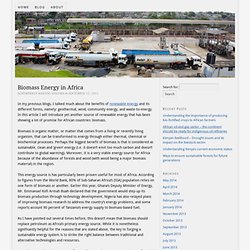
In this article I will introduce yet another source of renewable energy that has been showing a lot of promise for African countries: biomass. Biomass is organic matter, or matter that comes from a living or recently living organism, that can be transformed to energy through either thermal, chemical or biochemical processes. Perhaps the biggest benefit of biomass is that is considered as sustainable, clean and ‘green’ energy (i.e. it doesn’t emit too much carbon and doesn’t contribute to global warming).